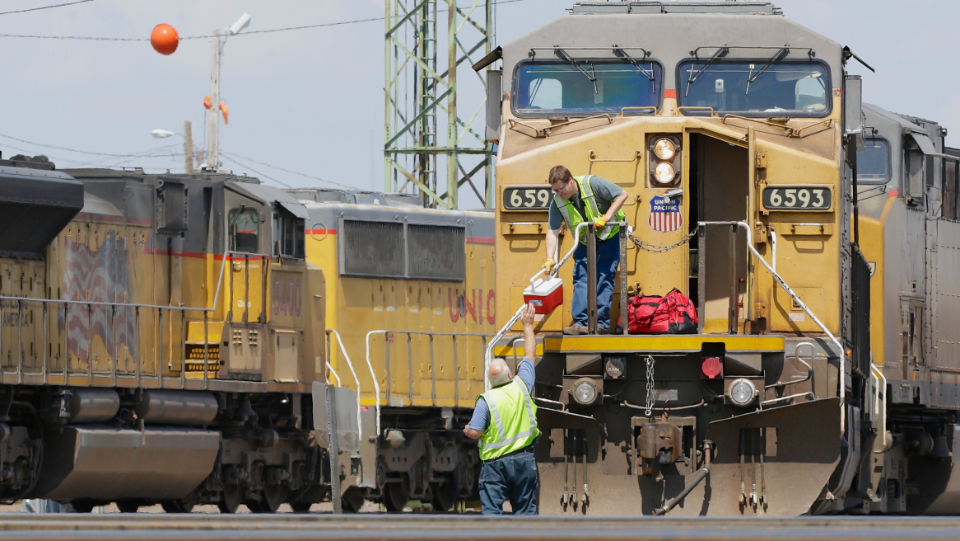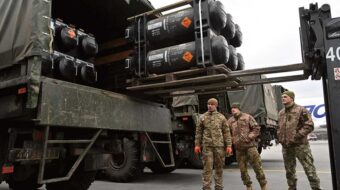
WASHINGTON (PAI)—Using safety of workers and communities as their main argument, two top railroad unions and the AFL-CIO Transportation Trades Department strongly argued for mandatory two-person crews on all freight trains.
TTD and unions carried their campaign to the Federal Railroad Administration (FRA) hearing on crews on Dec. 14, a day after rail workers’ rallied nationwide on another top issue, with its own safety component, paid sick and family leave. Congress nixed that when it imposed a new contract on the nation’s 115,000 freight rail workers.
The agency appears to be going in the other direction, for safety and against the freight railroads’ quest for higher profits by reducing crews to one person, the engineer. It received 13,090 comments on its proposed two-person crew mandate, unveiled in July. Most came from rank-and-file rail workers, supporting two-person crews.
By contrast, the carriers, especially the biggest Class I freight railroads, continued their campaign, which prior Republican Trump regime’s appointees at FRA supported, just for the engineer. Top executives at one big freight carrier, the Burlington Northern Santa Fe, advocated several years ago for crewless freight trains.
Advance word of that stand brought rail workers out onto an informational picket line, marshalled by Railroad Workers United, in front of the Chicago Loop hotel which hosted the closed-door honchos’ conference where BNSF advocated its scheme.
TTD President Greg Regan, speaking for all his unions, including all 14 rail craft unions, stated the railroads want to cut crews in pursuit of profits to satisfy Wall Street. The cost is worker exhaustion, safety problems, accidents, threats to communities from crashes—especially of tank cars with oil or hazardous chemicals—and declining service.
“Rail workers experience the demands and risks of the job daily, and we need to listen to them when they tell us they need safety protections,” Regan said. He pushed “strong, swift action” by the federal agency, part of the Transportation Department.
“Crew size is fundamentally a safety issue at its core, and two-person crews are inherently necessary to ensure the safe operation of our freight rail and passenger systems. By creating a federal standard across the industry, the FRA can address the significant safety concerns presented by railroads operating with single-person crews.”
While the rail bosses and workers have battled each other for years on two-person crews both in D.C., and in bargaining, rail workers and unions convinced several state legislatures to mandate each freight have both an engineer and a conductor. Key wins in the struggle have been in Illinois, the nation’s rail hub, and Nevada. Most rail freight to and from California passes through there. Other states have followed.
The railroads, Regan explained, claim they don’t need the conductor on freight trains because they now use Precision Scheduled Railroading (PSR), which produces “some of the most reckless and dangerous” conditions in “any industry in the past few years.” PSR also let the railroads cut their workforce by 30%, 45,000 workers, since 2015, and increased hazards to workers and communities.
Further, rail bosses often order the remaining workers to perform tasks, such as freight car inspections, for which they aren’t trained or qualified, Regan explained.

Rail workers now toil for two weeks straight without a break. Bosses can call them back on a moment’s notice on their day off to work for two more weeks. If they don’t show up, “points” are docked from their attendance records. If they need time see doctors, they get docked. Too many “points” off their records and they get fired.
That, too, is all in the pursuit of profits, Regan said. Such exploitation is why paid sick and family leave became such a flash point in bargaining and in Congress. The railroads absolutely refuse to discuss it.
PSR “exists solely to squeeze every last nickel and dime out of the industry. It exclusively serves the short-term benefit of the railroads’ shareholders at the expense of their workers” and customers. Money flowed: $146 billion in profits since 2015 for the big Class I freight railroads “to the detriment of workers, shippers, and consumers.” Even the robber barons earned less.
“Massive reductions in workforce are simply about cutting costs, even if those cuts result in the degradation of safety…In an industry where fatigue is a constant risk factor, exposing employees to additional fatigue by asking them to work longer, faster or perform multiple jobs, especially while sick, is a recipe for disaster.”
Such disasters can be avoided with a second pair of eyes—the conductor’s—on freight trains, Regan said. And the federal government must mandate it, not let the railroads force workers to trade say, wages, for safety.
Union leaders—Smart-Transportation Division President Jeremy Ferguson and Brotherhood of Locomotive Engineers & Trainmen/Teamsters Vice President Vincent Verna—added more evidence, as did four rank-and-file workers who spoke.
“There is no greater risk to the safety of railroad workers and the communities they serve than the consideration of a reduction in crew size in the cab of a locomotive,” Ferguson testified. “Having conductors on trains saves lives and prevents disasters in ways technology cannot. Artificial intelligence absolutely has a role to play, but it cannot replace authentic human intelligence in railroading.”
“Everyone who has worked on a railroad has had a close call,” the two unions added in their joint release. Even a voluntary accident reporting system would produce “a huge flood of data showing just how important the conductor is to avoiding accidents, like an engineer’s experience Ferguson mentioned in which a conductor got a three-year-old boy off the tracks before he was struck by the locomotive.”
FRA did not say when it would issue a final rule on two-person crews.












Comments